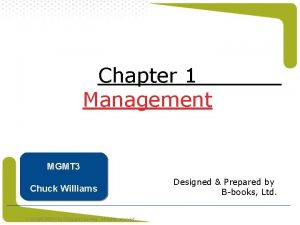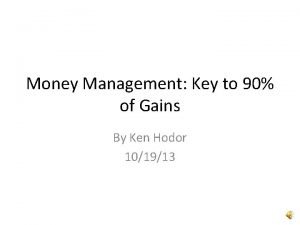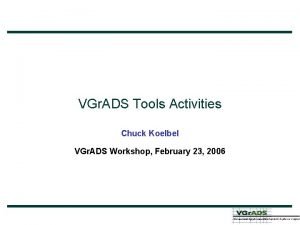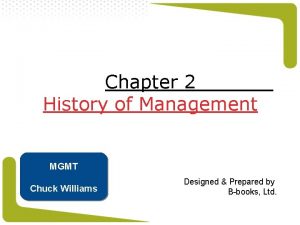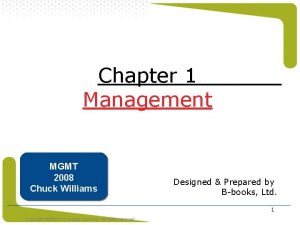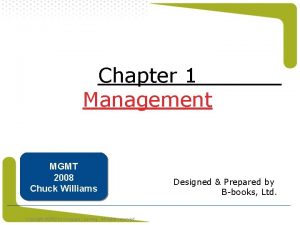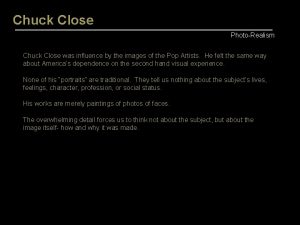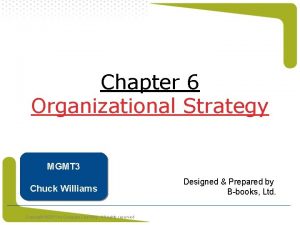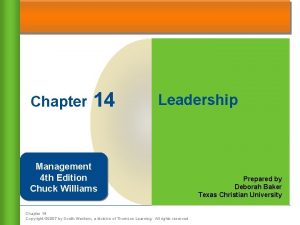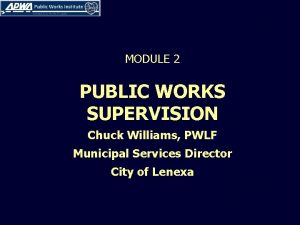Chapter 1 Management 4 th Edition Chuck Williams

































- Slides: 33

Chapter 1 Management 4 th Edition Chuck Williams Copyright © 2007 by South-Western, a division of Thomson Learning. All rights reserved Prepared by Deborah Baker Texas Christian University

What Would You Do? Headquarters, Amazon. com, Seattle, Georgia. § Amazon grew so fast that it lost control of the basics § Sales were growing, but the company was poorly managed § Amazon has lost over $3 billion since its inception, but is finally earning profits How can Amazon do a better job to fix what’s going wrong? Copyright © 2007 by South-Western, a division of Thomson Learning. All rights reserved 2

What Is Management? After reading the next two sections, you should be able to: 1. 2. describe what management is. explain the four functions of management. Copyright © 2007 by South-Western, a division of Thomson Learning. All rights reserved

Management Is… Getting work done through others Efficiency Effectiveness 1 Copyright © 2007 by South-Western, a division of Thomson Learning. All rights reserved

Management Functions Planning Organizing Leading Controlling 2 Copyright © 2007 by South-Western, a division of Thomson Learning. All rights reserved

Planning Determining organizational goals and a means for achieving them 2. 1 Copyright © 2007 by South-Western, a division of Thomson Learning. All rights reserved

What Really Works: Meta-Analysis General Mental Ability 10% 20% 30% 40% 50% 60% 70% 80% 90% 100% probability of success 76% Meta-Analysis is a study of studies that shows what works and when. This statistic shows that an employee hired on the basis of a good score on a general mental ability test stands a 76 percent chance of being a better performer than someone picked at random from the pool of all job applicants. Copyright © 2007 by South-Western, a division of Thomson Learning. All rights reserved

Organizing § Deciding where decisions will be made § Who will do what jobs and tasks § Who will work for whom 2. 2 Copyright © 2007 by South-Western, a division of Thomson Learning. All rights reserved 8

Leading Inspiring Leading Motivating For Anne Mulcahy, CEO of Xerox, the key to successful leadership is communicating with the company’s most important constituents: 2. 3 employees and customers. Copyright © 2007 by South-Western, a division of Thomson Learning. All rights reserved 9

Controlling Monitoring progress toward goal achievement and taking corrective action when needed 2. 4 Copyright © 2007 by South-Western, a division of Thomson Learning. All rights reserved

The Control Process Set standards to achieve goals Make changes to return performance to standards 2. 4 Copyright © 2007 by South-Western, a division of Thomson Learning. All rights reserved Compare actual performance to standards

What Do Managers Do? After reading the next two sections, you should be able to: 3. 4. describe different kinds of managers. explain the major roles and subroles that managers perform in their jobs. Copyright © 2007 by South-Western, a division of Thomson Learning. All rights reserved

Kinds of Managers § Top Managers § Middle Managers § First-Line Managers § Team Leaders 3 Copyright © 2007 by South-Western, a division of Thomson Learning. All rights reserved 13

Top Managers § Chief Executive Officer (CEO) § Chief Operating Officer (COO) § Chief Financial Officer (CFO) § Chief Information Officer (CIO) 3. 1 3 Copyright © 2007 by South-Western, a division of Thomson Learning. All rights reserved 14

Responsibilities of Top Managers Creating a context for change Developing commitment and ownership in employees Creating a positive organizational culture through language and action Monitoring their business environments 3. 1 Copyright © 2007 by South-Western, a division of Thomson Learning. All rights reserved 15

Middle Managers § Plant Manager § Regional Manager § Divisional Manager 3. 2 3 Copyright © 2007 by South-Western, a division of Thomson Learning. All rights reserved 16

Responsibilities of Middle Managers Plan and allocate resources to meet objectives Coordinate and link groups, departments, and divisions Monitor and manage the performance of subunits and managers who report to them Implement changes or strategies generated by top managers 3. 2 Copyright © 2007 by South-Western, a division of Thomson Learning. All rights reserved 17

First-Line Managers § Office Manager § Shift Supervisor § Department Manager 3. 3 3 Copyright © 2007 by South-Western, a division of Thomson Learning. All rights reserved 18

Responsibilities of First-Line Managers Manage the performance of entry-level employees Encourage, monitor, and reward the performance of workers Teach entry-level employees how to do their jobs Make detailed schedules and operating plans 3. 3 Copyright © 2007 by South-Western, a division of Thomson Learning. All rights reserved 19

Responsibilities of Team Leaders Facilitate team performance Manage external relations Facilitate internal team relationships 3. 4 Copyright © 2007 by South-Western, a division of Thomson Learning. All rights reserved 20

Managerial Roles Interpersonal Informational Decisional Figurehead Monitor Entrepreneur Leader Disseminator Disturbance Handler Liaison Spokesperson Resource Allocator 4 Negotiator Adapted from Exhibit 1. 4 H. Mintzberg, “The Manager’s Job: Folklore and Fact: . ” Harvard Business Review, July-August 1975. Copyright © 2007 by South-Western, a division of Thomson Learning. All rights reserved 21

Managerial Roles Interpersonal Roles Figurehead Managers perform ceremonial duties Leader Managers motivate and encourage workers to accomplish objectives Liaison Managers deal with people outside their units 4. 1 Copyright © 2007 by South-Western, a division of Thomson Learning. All rights reserved 22

Managerial Roles Informational Roles Monitor Managers scan their environment for information Disseminator Managers share information with others in their company Spokesperson 4. 2 Managers share information with others outside their departments or companies Copyright © 2007 by South-Western, a division of Thomson Learning. All rights reserved 23

Managerial Roles Decisional Roles Entrepreneur Disturbance Handler Resource Allocator Negotiator 4. 3 Managers adapt to incremental change Managers respond to problems that demand immediate action Managers decide who gets what resources Managers negotiate schedules, projects, goals, outcomes, resources, and raises Copyright © 2007 by South-Western, a division of Thomson Learning. All rights reserved 24

What Does It Take to Be a Manager? After reading the next three sections, you should be able to: 5. explain what companies look for in managers. 6. discuss the top mistakes that managers make in their jobs. 7. describe the transition that employees go through when they are promoted to management. Copyright © 2007 by South-Western, a division of Thomson Learning. All rights reserved 25

What Companies Look for in Managers Technical Skills Human Skills Conceptual Skills Motivation to Manage 5 Copyright © 2007 by South-Western, a division of Thomson Learning. All rights reserved

What Companies Look for in Managers Skills are more or less important at different levels of management: 5 Copyright © 2007 by South-Western, a division of Thomson Learning. All rights reserved

Mistakes Managers Make 1. Insensitive to others 2. Cold, aloof, arrogant 3. Betrayal of trust 4. Overly ambitious 5. Specific performance problems with the business 6. Overmanaging: unable to delegate or build a team 7. Unable to staff effectively 8. Unable to think strategically 9. Unable to adapt to boss with different style 10. Overdependent on advocate or mentor 6 Adapted from Exhibit 1. 6 Mc. Call & Lombardo, “What Makes a Top Executive? ” Psychology Today, Feb 1983 Copyright © 2007 by South-Western, a division of Thomson Learning. All rights reserved

The First Year Management Transition Managers’ Initial Expectations ¤ Be the boss ¤ Formal authority ¤ Manage tasks ¤ Job is not managing people After Six Months As a Manager ¤ Initial expectations were wrong ¤ Fast pace ¤ Heavy workload After a Year As a Manager ¤ No longer “doer” ¤ Communication, listening, positive reinforcement ¤ Learning to adapt ¤ Job is to be and control stress problem-solver and troubleshooter ¤ Job is people development 7 Adapted from Exhibit 1. 7 Copyright © 2007 by South-Western, a division of Thomson Learning. All rights reserved

Why Management Matters After reading this section, you should be able to: 8. explain how and why companies can create competitive advantage through people. Copyright © 2007 by South-Western, a division of Thomson Learning. All rights reserved 30

Competitive Advantage through People Management Practices in Top Performing Companies 1. Employment Security 2. Selective Hiring 3. Self-Managed Teams and Decentralization 4. High Wages Contingent on Organizational Performance 5. Training and Skill Development 6. Reduction of Status Differences 7. Sharing Information 8 Adapted from Exhibit 1. 8 Copyright © 2007 by South-Western, a division of Thomson Learning. All rights reserved

Competitive Advantage through People J. M. Smucker Company has been on Fortune’s list of 100 Best Companies to Work For since the list was started in 1998. Smucker’s has extremely low employee turnover and extremely high employee satisfaction. Tim and Richard Smucker are pictured here. Copyright © 2007 by South-Western, a division of Thomson Learning. All rights reserved

Competitive Advantage through People Competitive Advantages of Well-Managed Companies 8 Sales Revenues Profits Stock Market Returns Customer Satisfaction Web Link http: //www. greatplacetowork. com/best/list-bestusa. htm Copyright © 2007 by South-Western, a division of Thomson Learning. All rights reserved
 Management by chuck williams
Management by chuck williams Verna and sam williams case study
Verna and sam williams case study Andy williams robert williams
Andy williams robert williams Robbie williams janet williams
Robbie williams janet williams Mis chapter 6
Mis chapter 6 Mis
Mis Principles of management robbins and coulter
Principles of management robbins and coulter Larry williams money management
Larry williams money management Linda, chuck close
Linda, chuck close 3-jaw chuck grasp
3-jaw chuck grasp Aviation
Aviation Pitot tube bernoulli equation
Pitot tube bernoulli equation Gdc arki
Gdc arki Cast away chuck noland character analysis
Cast away chuck noland character analysis Chuck baird turtle
Chuck baird turtle Chuck tolbert
Chuck tolbert Network chuck kasm
Network chuck kasm Chuck cusack
Chuck cusack Pillar drill bit
Pillar drill bit Chuck sox membuat kotak kayu
Chuck sox membuat kotak kayu Lucas by chuck close
Lucas by chuck close Chuck cusack
Chuck cusack Chuck close self portrait 1977
Chuck close self portrait 1977 Chuck berry
Chuck berry Chuck close childhood
Chuck close childhood Chuck grimm
Chuck grimm Chuck close youtube
Chuck close youtube Chuck close children
Chuck close children Chuck thacker
Chuck thacker Chuck recalls the day last summer
Chuck recalls the day last summer Julio has fragmented thinking and distorted false beliefs
Julio has fragmented thinking and distorted false beliefs Chuck moran skillsoft
Chuck moran skillsoft Chuck connell
Chuck connell Chuck allison
Chuck allison
